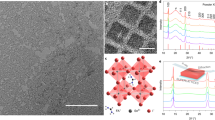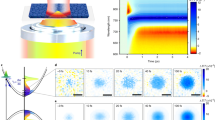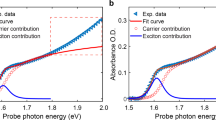Abstract
We study the carrier dynamics in planar methyl ammonium lead iodide perovskite films using broadband transient absorption spectroscopy. We show that the sharp optical absorption onset is due to an exciton transition that is inhomogeneously broadened with a binding energy of 9 meV. We fully characterize the transient absorption spectrum by free-carrier-induced bleaching of the exciton transition, quasi-Fermi energy, carrier temperature and bandgap renormalization constant. The photo-induced carrier temperature is extracted from the transient absorption spectra and monitored as a function of delay time for different excitation wavelengths and photon fluences. We find an efficient hot-phonon bottleneck that slows down cooling of hot carriers by three to four orders of magnitude in time above a critical injection carrier density of ∼5 × 1017 cm−3. Compared with molecular beam epitaxially grown GaAs, the critical density is an order of magnitude lower and the relaxation time is approximately three orders of magnitude longer.
This is a preview of subscription content, access via your institution
Access options
Subscribe to this journal
Receive 12 print issues and online access
$209.00 per year
only $17.42 per issue
Buy this article
- Purchase on Springer Link
- Instant access to full article PDF
Prices may be subject to local taxes which are calculated during checkout





Similar content being viewed by others
References
Im, J.-H., Lee, C.-R., Lee, J.-W., Park, S.-W. & Park, N.-G. 6.5% efficient perovskite quantum-dot-sensitized solar cell. Nanoscale 3, 4088–4093 (2011).
Kim, H.-S. et al. Lead iodide perovskite sensitized all-solid-state submicron thin film mesoscopic solar cell with efficiency exceeding 9%. Sci. Rep. 2, 591 (2012).
Lee, M. M., Teuscher, J., Miyasaka, T., Murakami, T. N. & Snaith, H. J. Efficient hybrid solar cells based on meso-superstructured organometal halide perovskites. Science 338, 643–647 (2012).
Burschka, J. et al. Sequential deposition as a route to high-performance perovskite-sensitized solar cells. Nature 499, 316–319 (2013).
Liu, D. & Kelly, T. L. Perovskite solar cells with a planar heterojunction structure prepared using room-temperature solution processing techniques. Nature Photon. 8, 133–138 (2014).
Liu, M., Johnston, M. B. & Snaith, H. J. Efficient planar heterojunction perovskite solar cells by vapour deposition. Nature 501, 395–398 (2013).
Tan, Z.-K. et al. Bright light-emitting diodes based on organometal halide perovskite. Nature Nanotech. 9, 687–692 (2014).
Fang, Y., Dong, Q., Shao, Y., Yuan, Y. & Huang, J. Highly narrowband perovskite single-crystal photodetectors enabled by surface-charge recombination. Nature Photon. 9, 679–686 (2015).
Zhu, H. et al. Lead halide perovskite nanowire lasers with low lasing thresholds and high quality factors. Nature Mater. 14, 636–642 (2015).
Xing, G. et al. Low-temperature solution-processed wavelength-tunable perovskites for lasing. Nature Mater. 13, 476–480 (2014).
Manser, J. S. & Kamat, P. V. Band filling with free charge carriers in organometal halide perovskites. Nature Photon. 8, 737–743 (2014).
Xing, G. et al. Long-range balanced electron- and hole-transport lengths in organic–inorganic CH3NH3PbI3 . Science 342, 344–347 (2013).
Elliott, R. J. Intensity of optical absorption by excitons. Phys. Rev. 108, 1384–1389 (1957).
Sturge, M. D. Optical absorption of gallium arsenide between 0.6 and 2.75 eV. Phys. Rev. 127, 768–773 (1962).
Wiesenfeld, J. M. & Taylor, A. J. Picosecond band filling in highly excited In-Ga-As-P films. Phys. Rev. B 34, 8740–8749 (1986).
Puthussery, J., Lan, A., Kosel, T. H. & Kuno, M. Band-filling of solution-synthesized CdS nanowires. ACS Nano 2, 357–367 (2008).
Huang, D., Chyi, J.-I. & Morkoç, H. Carrier effects on the excitonic absorption in GaAs quantum-well structures: phase-space filling. Phys. Rev. B 42, 5147–5153 (1990).
Calcagnile, L. et al. Free-carrier effects on the excitonic absorption of n-type modulation-doped Zn1–xCdxSe/ZnSe multiple quantum wells. Phys. Rev. B 52, 17248–17253 (1995).
Lee, Y. H. et al. Room-temperature optical nonlinearities in GaAs. Phys. Rev. Lett. 57, 2446–2449 (1986).
Shah, J., Leheny, R. F. & Lin, C. Dynamic Burstein shift in GaAs. Solid State Commun. 18, 1035–1037 (1976).
Yin, W.-J., Shi, T. & Yan, Y. Unique properties of halide perovskites as possible origins of the superior solar cell performance. Adv. Mater. 26, 4653–4658 (2014).
Amat, A. et al. Cation-induced band-gap tuning in organohalide perovskites: interplay of spin–orbit coupling and octahedra tilting. Nano Lett. 14, 3608–3616 (2014).
Giorgi, G., Fujisawa, J.-I., Segawa, H. & Yamashita, K. Small photocarrier effective masses featuring ambipolar transport in methylammonium lead iodide perovskite: a density functional analysis. J. Phys. Chem. Lett. 4, 4213–4216 (2013).
Chemla, D. S., Miller, D. A. B., Smith, P. W., Gossard, A. C. & Wiegmann, W. Room temperature excitonic nonlinear absorption and refraction in GaAs/AlGaAs multiple quantum well structures. IEEE J. Quantum Electron. 20, 265–275 (1984).
Brinkman, W. F. & Rice, T. M. Electron–hole liquids in semiconductors. Phys. Rev. B 7, 1508–1523 (1973).
Binet, F., Duboz, J. Y., Off, J. & Scholz, F. High-excitation photoluminescence in GaN: hot-carrier effects and the Mott transition. Phys. Rev. B 60, 4715–4722 (1999).
Tanaka, S., Kobayashi, H., Saito, H. & Shionoya, S. Luminescence of high density electron–hole plasma in GaAs. J. Phys. Soc. Jpn 49, 1051–1059 (1980).
Ryan, J. F. et al. Time-resolved photoluminescence of two-dimensional hot carriers in GaAs–AlGaAs heterostructures. Phys. Rev. Lett. 53, 1841–1844 (1984).
Von der Linde, D. & Lambrich, R. Direct measurement of hot-electron relaxation by picosecond spectroscopy. Phys. Rev. Lett. 42, 1090–1093 (1979).
Leheny, R. F., Shah, J., Fork, R. L., Shank, C. V. & Migus, A. Dynamics of hot carrier cooling in photo-excited GaAs. Solid State Commun. 31, 809–813 (1979).
Kash, K. & Shah, J. Carrier energy relaxation in In0.53Ga0.47As determined from picosecond luminescence studies. Appl. Phys. Lett. 45, 401–403 (1984).
Zanato, D., Balkan, N., Ridley, B. K., Hill, G. & Schaff, W. J. Hot electron cooling rates via the emission of LO-phonons in InN. Semicond. Sci. Technol. 19, 1024–1028 (2004).
Huang, L.-y. & Lambrecht, W. R. L. Electronic band structure, phonons, and exciton binding energies of halide perovskites CsSnCl3, CsSnBr3, and CsSnI3 . Phys. Rev. B 88, 165203 (2013).
Rosenwaks, Y. et al. Hot-carrier cooling in GaAs: quantum wells versus bulk. Phys. Rev. B 48, 14675–14678 (1993).
Pelouch, W. S. et al. Comparison of hot-carrier relaxation in quantum wells and bulk GaAs at high carrier densities. Phys. Rev. B 45, 1450–1453 (1992).
Shah, J. Hot electrons and phonons under high intensity photoexcitation of semiconductors. Solid-State Electron. 21, 43–50 (1978).
Yoffa, E. J. Screening of hot-carrier relaxation in highly photoexcited semiconductors. Phys. Rev. B 23, 1909–1919 (1981).
Pötz, W. Hot-phonon effects in bulk GaAs. Phys. Rev. B 36, 5016–5019 (1987).
Joshi, R. P. & Ferry, D. K. Hot-phonon effects and interband relaxation processes in photoexcited GaAs quantum wells. Phys. Rev. B 39, 1180–1187 (1989).
Rühle, W. W., Leo, K. & Bauser, E. Cooling of a hot electron–hole plasma in AlxGa1–xAs. Phys. Rev. B 40, 1756–1761 (1989).
Conibeer, G., Guillemoles, J., Yu, F. & Levard, H. in Advanced Concepts in Photovoltaics (eds Nozik, A. J., Conibeer, G. & Beard, M. C.) Ch. 12, 379–424 (Royal Society of Chemistry, 2014).
Kuo, S.-Y., Li, C.-T. & Hsieh, W.-F. Decreasing giant splitting of longitudinal and transverse optical phonons in PbxSr1−xTiO3 due to Pb covalency. Appl. Phys. Lett. 81, 3019–3021 (2002).
Acknowledgements
The authors thank A.J. Nozik for discussions. This work was supported by the Division of Chemical Sciences, Geosciences, and Biosciences, Office of Basic Energy Sciences of the US Department of Energy through the Solar Photochemistry programme contract no. DE-AC36-08GO28308 to the National Renewable Energy Laboratory, Golden, CO. J.M.L. was supported by the US Department of Energy/National Renewable Energy Laboratory's Laboratory Directed Research and Development (LDRD) programme. The authors thank S. Saha for preparing some of the perovskite films. The publisher, by accepting the article for publication, acknowledges that the US Government retains a non-exclusive, paid up, irrevocable, worldwide licence to publish or reproduce the published form of this work, or allow others to do so, for US Government purposes.
Author information
Authors and Affiliations
Contributions
Y.Y. and M.C.B. conceived the experiments. Y.Y. carried out the transient absorption measurements. D.P.O. and K.Z. prepared the perovskite samples. R.M.F. prepared the GaAs samples. J.M.L. performed XRD measurements. Y.Y. and M.C.B. analysed the data. Y.Y., M.C.B. and J.v.d.L. wrote the manuscript with input from all authors.
Corresponding author
Ethics declarations
Competing interests
The authors declare no competing financial interests.
Supplementary information
Supplementary information
Supplementary information (PDF 2910 kb)
Rights and permissions
About this article
Cite this article
Yang, Y., Ostrowski, D., France, R. et al. Observation of a hot-phonon bottleneck in lead-iodide perovskites. Nature Photon 10, 53–59 (2016). https://doi.org/10.1038/nphoton.2015.213
Received:
Accepted:
Published:
Issue Date:
DOI: https://doi.org/10.1038/nphoton.2015.213
This article is cited by
-
Anisotropic carrier dynamics and laser-fabricated luminescent patterns on oriented single-crystal perovskite wafers
Nature Communications (2024)
-
Alloying metal cations in perovskite nanocrystals is a new route to controlling hot carrier cooling
Light: Science & Applications (2023)
-
Thermalization and relaxation mediated by phonon management in tin-lead perovskites
Light: Science & Applications (2023)
-
Gigantic suppression of recombination rate in 3D lead-halide perovskites for enhanced photodetector performance
Nature Photonics (2023)
-
Ultrafast relaxation of lattice distortion in two-dimensional perovskites
Nature Physics (2023)



